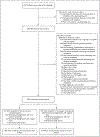Noninvasive Ventilation for Preoxygenation during Emergency Intubation
- PMID: 38869091
- PMCID: PMC11282951
- DOI: 10.1056/NEJMoa2313680
Noninvasive Ventilation for Preoxygenation during Emergency Intubation
Abstract
Background: Among critically ill adults undergoing tracheal intubation, hypoxemia increases the risk of cardiac arrest and death. The effect of preoxygenation with noninvasive ventilation, as compared with preoxygenation with an oxygen mask, on the incidence of hypoxemia during tracheal intubation is uncertain.
Methods: In a multicenter, randomized trial conducted at 24 emergency departments and intensive care units in the United States, we randomly assigned critically ill adults (age, ≥18 years) undergoing tracheal intubation to receive preoxygenation with either noninvasive ventilation or an oxygen mask. The primary outcome was hypoxemia during intubation, defined by an oxygen saturation of less than 85% during the interval between induction of anesthesia and 2 minutes after tracheal intubation.
Results: Among the 1301 patients enrolled, hypoxemia occurred in 57 of 624 patients (9.1%) in the noninvasive-ventilation group and in 118 of 637 patients (18.5%) in the oxygen-mask group (difference, -9.4 percentage points; 95% confidence interval [CI], -13.2 to -5.6; P<0.001). Cardiac arrest occurred in 1 patient (0.2%) in the noninvasive-ventilation group and in 7 patients (1.1%) in the oxygen-mask group (difference, -0.9 percentage points; 95% CI, -1.8 to -0.1). Aspiration occurred in 6 patients (0.9%) in the noninvasive-ventilation group and in 9 patients (1.4%) in the oxygen-mask group (difference, -0.4 percentage points; 95% CI, -1.6 to 0.7).
Conclusions: Among critically ill adults undergoing tracheal intubation, preoxygenation with noninvasive ventilation resulted in a lower incidence of hypoxemia during intubation than preoxygenation with an oxygen mask. (Funded by the U.S. Department of Defense; PREOXI ClinicalTrials.gov number, NCT05267652.).
Copyright © 2024 Massachusetts Medical Society.
Figures


Comment in
-
Noninvasive Ventilation for Preoxygenation during Emergency Intubation.N Engl J Med. 2024 Sep 19;391(11):1068-1069. doi: 10.1056/NEJMc2409126. N Engl J Med. 2024. PMID: 39292940 No abstract available.
-
Noninvasive Ventilation for Preoxygenation during Emergency Intubation.N Engl J Med. 2024 Sep 19;391(11):1069. doi: 10.1056/NEJMc2409126. N Engl J Med. 2024. PMID: 39292941 No abstract available.
-
Noninvasive Ventilation for Preoxygenation during Emergency Intubation. Reply.N Engl J Med. 2024 Sep 19;391(11):1069-1070. doi: 10.1056/NEJMc2409126. N Engl J Med. 2024. PMID: 39292942 No abstract available.
References
-
- Pfuntner A, Wier LM, Stocks C. Most frequent procedures performed in U.S. hospitals, 2011. Statistical brief no. 165. Rockville, MD: Agency for Healthcare Research and Quality, October 2013. - PubMed
-
- Cairns CKK, Santo L. National Hospital Ambulatory Medical Care Survey: 2018 emergency department summary tables. Washington, DC: National Center for Health Statistics, 2018. (https://www.cdc.gov/nchs/data/nhamcs/web_tables/2018-ed-web-tables-508.pdf).
-
- Smischney NJ, Khanna AK, Brauer E, et al. Risk factors for and outcomes associated with peri-intubation hypoxemia: a multicenter prospective cohort study. J Intensive Care Med 2021;36:1466–74. - PubMed
Publication types
MeSH terms
Substances
Associated data
Grants and funding
LinkOut - more resources
Full Text Sources
Medical
